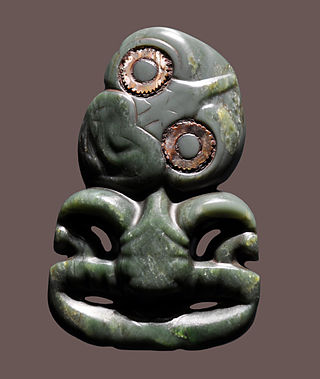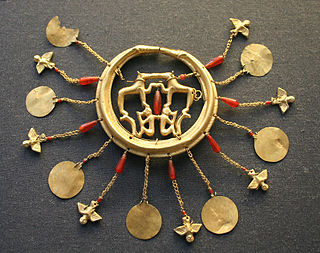
Jewellery consists of decorative items worn for personal adornment, such as brooches, rings, necklaces, earrings, pendants, bracelets, and cufflinks. Jewellery may be attached to the body or the clothes. From a western perspective, the term is restricted to durable ornaments, excluding flowers for example. For many centuries metal such as gold often combined with gemstones, has been the normal material for jewellery, but other materials such as glass, shells and other plant materials may be used.

A necklace is an article of jewellery that is worn around the neck. Necklaces may have been one of the earliest types of adornment worn by humans. They often serve ceremonial, religious, magical, or funerary purposes and are also used as symbols of wealth and status, given that they are commonly made of precious metals and stones.

Filigree is a form of intricate metalwork used in jewellery and other small forms of metalwork.

The National Museum in New Delhi, also known as the National Museum of India, is one of the largest museums in India. Established in 1949, it holds a variety of articles ranging from pre-historic era to modern works of art. It functions under the Ministry of Culture, Government of India. The museum is situated on Janpath. The blue–print of the National Museum had been prepared by the Gwyer Committee set up by the Government of India in 1946. The museum has around 200,000 works of art, mostly Indian, but some of foreign origin, covering over 5,000 years.

Jewellery making in the Pacific started later than in other areas, due to relatively recent human settlement. Early Polynesian jewellery, which was made of bone, wood and other natural materials, has not survived. The precise start of island jewellery-making is difficult to pinpoint, due to many of the island nations' founders migrating there from other areas, such as Tahiti.

The Jewels of the Nizams of Hyderabad State are among the largest and most expensive collection of jewels in present-day India. The jewels belonged to the Nizams. After the annexation of their kingdom by Union of India, the Nizam and his heirs were barred by the Indian government from taking the collection, claiming that it was a national treasure. After much litigation, the diamond was purchased by the Government of India from the Nizam's trust for an estimated $13 million in 1995, along with other jewels of the Nizams, and is held at the Reserve Bank of India vaults in Mumbai.

The culture of Rajasthan includes many artistic traditions that reflect the ancient Indian way of life. Rajasthan is also called the "Land of Kings". It has many tourist attractions and facilities for tourists. This historical state of India attracts tourists and vacationers with its rich culture, tradition, heritage and monuments. It also has some wildlife sanctuaries and national parks.
Rajasthani people or Rajasthanis are a group of Indo-Aryan peoples native to Rajasthan, a state in Northern India. Their language, Rajasthani, is a part of the western group of Indo-Aryan languages.

The City Palace, Jaipur is a royal residence and former administrative headquarters of the rulers of the Jaipur State in Jaipur, Rajasthan. Construction started soon after the establishment of the city of Jaipur under the reign of Maharaja Sawai Jai Singh II, who moved his court to Jaipur from Amber, in 1727. Jaipur remained the capital of the kingdom until 1949—when it became the capital of the present-day Indian state of Rajasthan—with the City Palace functioning as the ceremonial and administrative seat of the Maharaja of Jaipur. The construction of the Palace was completed in 1732 and it was also the location of religious and cultural events, as well as a patron of arts, commerce, and industry. It was constructed according to the rules of vastushastra, combining elements of Mughal and Rajput architectural styles. It now houses the Maharaja Sawai Man Singh II Museum, and continues to be the home of the Jaipur royal family. The royal family has around 500 personal servants. The palace complex has several buildings, various courtyards, galleries, restaurants, and offices of the Museum Trust.The MSMS II Museum Trust is headed by chairperson Rajamata Padmini Devi of Jaipur. Princess Diya Kumari runs the Museum Trust, as its secretary and trustee. She also manages The Palace School and Maharaja Sawai Bhawani Singh School in Jaipur. She founded and runs the Princess Diya Kumari Foundation to empower underprivileged and underemployed women of Rajasthan. She is also an entrepreneur. In 2013, she was elected as Member of the Legislative Assembly of Rajasthan from the constituency of Sawai Madhopur.

Abhaneri, also spelled Abaneri, is a village in the Dausa district of the Indian state of Rajasthan. Abhaneri yields ruins of an ancient city, Abhangari, now popular for the Chand Baori step well and Harshat Mata Temple. It is situated at the Jaipur-Agra Highway. The site was first reported by B L Dhama in 1903 when he prepared List of Objects of Antiquarian Interest in the States of Rajputana Beside the step well and the temple, it has many fine sculptures of early Pratihara art of the region. Many of its loose sculptures are housed in display or reserve collections at many museums such as Govt. Museum, Amber. Albert Hall Museum, Jaipur, Hawamahal City Palace, and Archaeological Survey of India. Indian Government issued a postal stamp depicting the Chand Baori in 2017.

The Jawahar Kala Kendra (JKK) is a multi-arts center located in the city of Jaipur, India. It was built by the Government of Rajasthan to preserve Rajasthani arts and crafts. The center has eight blocks housing museums, an amphitheater, a closed auditorium, a library, arts display rooms, a cafeteria, a small hostel, and an art studio. It also houses two permanent art galleries and three others, and it hosts its yearly theatre festival.

The Albert Hall Museum in Jaipur is the oldest museum of the state and functions as the state museum of Rajasthan, India. The building is situated in Ram Niwas garden outside the city wall opposite New gate and is a fine example of Indo-Saracenic architecture. It is also called the Government Central Museum. It was considered one of the best 19th century museums for the variety of its collections. It was renovated in 2008 and reopened as one of the most advanced museums in India.

The Zelnik István Southeast Asian Gold Museum is a private museum located on Andrássy Street in the Terézváros district of Budapest, Hungary.

The Aegina Treasure or Aigina Treasure is an important Minoan gold hoard said to have been found on the island of Aegina, Greece. Since 1892, it has been part of the British Museum's collection. It is one of the most important groups of Minoan jewellery.

The Beaurains Treasure is the name of an important Roman hoard found in Beaurains, a suburb of the city of Arras, northern France in 1922. Soon after its discovery, much of the treasure was dispersed, to be sold on the antiquities market. The largest portion of the hoard can be found in the local museum in Arras and in the British Museum.

Amrapali Jewels, is a jewellery house founded in 1978 by Rajiv Arora and Rajesh Ajmera in Jaipur. Amrapali designs, produces and distributes tribal, fine and uncut gemstone jewellery. The brand has stores in India and London. The brand also operates a museum of Indian jewellery in Jaipur.

Ancient Roman jewelry was characterized by an interest in colored gemstones and glass, in contrast with their Greek predecessors who focused primarily on the production of high-quality metalwork by practiced artisans. Extensive control of Mediterranean territories provided an abundance of natural resources to utilize in jewelry making. Participation in trade allowed access to both semi-precious and precious stones that traveled down the Persian Silk Road from the East.
The Sardar Government Museum is located in Public Park, Jodhpur, Rajasthan, India. The museum is named in memory of Maharaja Sardar Singh, a ruler of Jodhpur from 1895 to 1911. It was constructed under the reign of his son, Maharaja Umed Singh. It was built by Henry Vaughan Lanchester in 1909 and formally opened to the public on 17 March, 1936. The area of the museum is approx. 18,000 sq.ft. On 22 June 2018, the re-planned museum was inaugurated by Smt. Vasundhara Raje, the Chief Minister of Rajasthan.

Jewelleryof the Berber cultures is a historical style of traditional jewellery that was worn by women mainly in rural areas of the Maghreb region in North Africa and inhabited by indigenous Berber people. Following long social and cultural traditions, Berber or other silversmiths in Morocco, Algeria and neighbouring countries created intricate jewellery with distinct regional variations. In many towns and cities, there were Jewish silversmiths, who produced both jewellery in specific Berber styles as well as in other styles, adapting to changing techniques and artistic innovations.

The pottery collection of the Albert Hall Museum in Jaipur, India, is a diverse 19th-century collection. The collection represents a wide range of crafts, techniques, and regions. The display includes unglazed vessels with ornamental decoration. The pottery techniques on display include burnished, lacquered, slip-painted, incised wares, and glazed pottery. The museum has representative pieces of Indian craftsmanship and other international pottery styles.







































